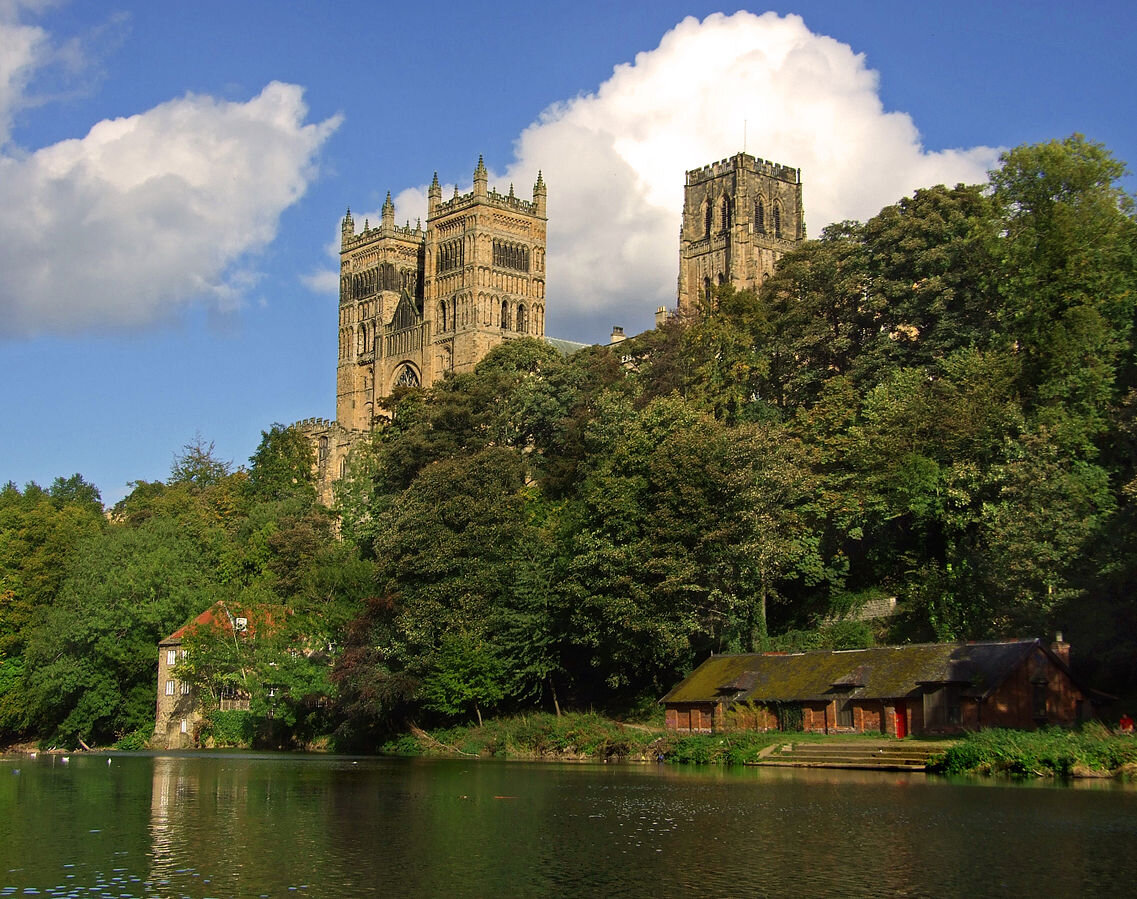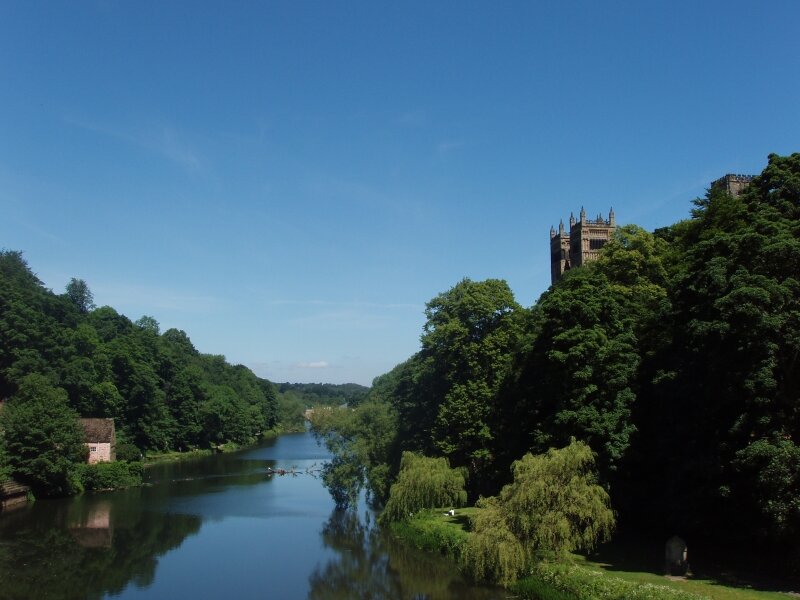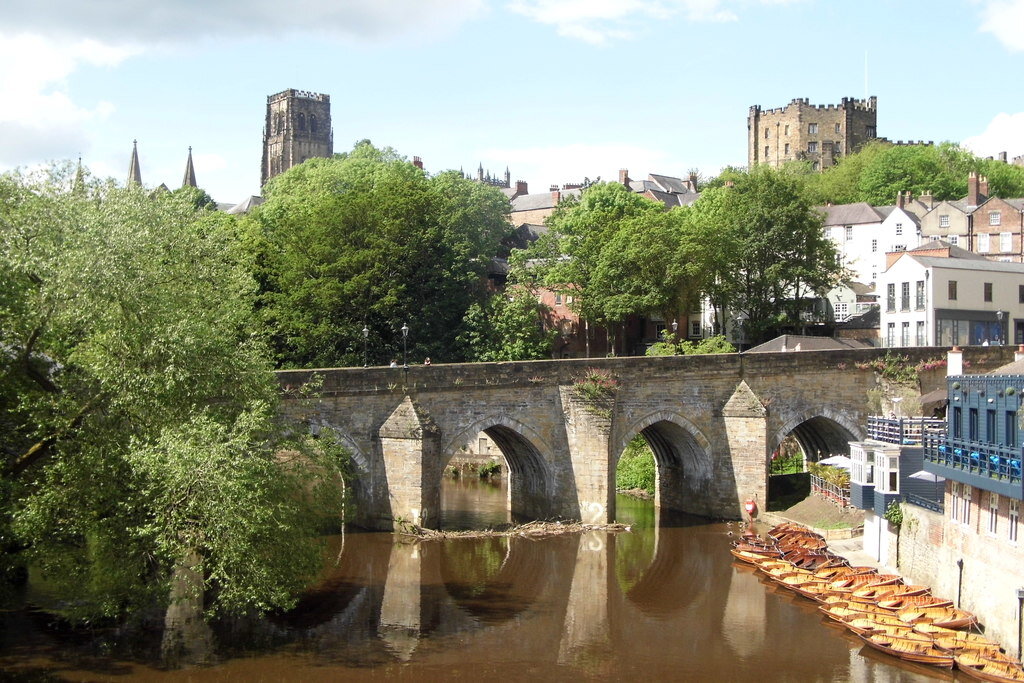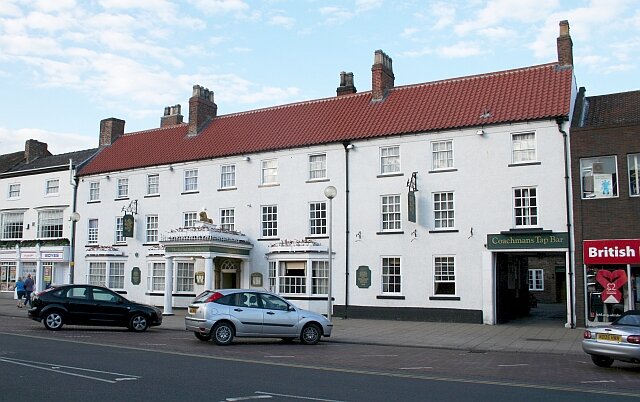Friday 29th October 1819
Friday Oct 29th We breakfasted at Durham 15 miles from Newcastle; the cathedral here is a magnificent building of Saxon architecture it stands on an eminence overlooking the town here we saw the grave of St Cuthbert near the Cathedral stands the Castle a very old building part of it is inhabited, on the side of the river Wear which divides the town are some very pretty public walks there are two handsome bridges over the river; the town is nothing very striking we then proceeded to Rushyford 9 miles thence to Darlington 9 miles which appears a nice town; the country
about here is not at all interesting from Darlington to Northallerton 16 miles where we slept the Inn is very good
OBSERVATIONS & COMMENTS:
Durham: Local legend states that the city was founded in A.D. 995 by divine intervention. Durham's geographical position has always given it an important place in the defence of England against the Scots. The city played an important part in the defence of the north, and Durham Castle is the only Norman castle keep never to have suffered a breach. The Battle of Neville's Cross, which took place near the city on 17 October 1346 between the English and Scots, is the most famous battle of the age.
1610: A map of Durham, England from 1610, by the famous cartographer John Speed. The cathedral and castle are shown, as is the River Wear which surrounds the city on three sides. This work is in the public domain. https://commons.wikimedia.org/wiki/File:Durham_1610.jpg
1749: The South-West Prospect of the City of Durham, the Universal Magazine Series, Artist S & N Buck, Publisher: J. Hinton at the Kings Arms in St Pauls Church Yard London http://www.rareoldprints.com/z/18341
Durham from Pelaw Wood , Artist: W R Robinson, Engraver: George Hawkins (1809-1852), Publisher: Andrews, Durham, Printed by Day & Haghe. http://www.rareoldprints.com/z/6892
1850: City of Durham, from the Observatory Fields. Artist: J W Carmichael, Engraver: J T Willmore, Publisher: George Andrews, Durham and S & J Fuller, 34 Rathbone Place London http://www.rareoldprints.com/z/23323
Charles I came to Durham towards the end of the civil war, escaping from the city as Oliver Cromwell's forces got closer. Local legend has it that Cromwell stayed in a room in the present Royal County Hotel that is reputed to be haunted by his ghost. Durham suffered greatly during the civil war and Commonwealth. due to the closure of religious institutions. pertaining to it. The city has always relied upon the Dean and Chapter and cathedral as an economic force. In 1720 it was proposed that Durham could become a sea port by digging a canal north to join the River Team, a tributary of the River Tyne near Gateshead. Nothing came of the plan, but the statue of Neptune in the Market Place was a constant reminder of Durham's maritime possibilities. The 18th century also saw the rise of the trade union movement in the city. https://en.wikipedia.org/wiki/Durham,_England
Durham roofscape . © Copyright Mike Quinn and licensed for reuse under the (CC BY-SA 2.0) Creative Commons Licence. https://www.geograph.org.uk/photo/897766
Framwelgate Bridge crossing the River Wear, Overlooked by Durham Castle. The castle was originally built in the 11th century. It has been occupied since 1840 by the University College, and is home to over 100 students. It is open to the general public to visit, but only through guided tours. Durham Castle is jointly designated a UNESCO World Heritage Site with Durham Cathedral. © Copyright Mat Fascione and licensed for reuse under the (CC BY-SA 2.0) Creative Commons Licence. https://www.geograph.org.uk/photo/5640690
Durham cathedral: The 12th century chronicler Symeon of Durham recounts that in AD 995 after wandering in the north, Saint Cuthbert's bier miraculously came to a halt at the hill of Warden Law and, despite the effort of the congregation, would not move. According to this legend, by chance later that day, the monks came across a milkmaid who stated that she was seeking her lost dun cow, which she had last seen at Dun Holm. The monks, realising that this was a sign from the saint, followed her and settled at a high wooded rock surrounded on three sides by the River Wear where they erected a shelter for the relics, on the spot where the Durham Cathedral would later stand.
1998: Depiction of the dun cow that helped in the founding of Durham. (Much more information about this legend available in British Museum file showing a copy of this artwork: Dun-Cow--Durham-Cathedral-British-Museum.png) . Photograph by Rebecca Kennison, the copyright holder of this work, and published under the following licenses: the GNU Free Documentation License, Version 1.2 or any later version published by the Free Software Foundation; with no Invariant Sections, no Front-Cover Texts, and no Back-Cover Texts. A copy of the license is included in the section entitled GNU Free Documentation License. This file is licensed under the (CC BY-SA 3.0) Creative Commons Attribution-Share Alike 3.0 Unported license. https://commons.wikimedia.org/wiki/File:UK_Durham_Dun-Cow.jpg
Durham Cathedral holds the relics of Saint Cuthbert, transported to Durham by Lindisfarne monks in the ninth century, the head of Saint Oswald of Northumbria, and the remains of the Venerable Bede. In addition, its library contains one of the most complete sets of early printed books in England, the pre-Dissolution monastic accounts, and three copies of the Magna Carta. Cuthbert's tomb was destroyed on the orders of King Henry VIII in 1538, and the monastery's wealth handed over to the king. The body of the saint was exhumed, and according to the Rites of Durham, was discovered to be uncorrupted. It was reburied under a plain stone slab worn by the knees of pilgrims, but the ancient paving around it remains intact. Two years later, on 31 December 1540, the Benedictine monastery at Durham was dissolved. After the Battle of Dunbar on 3 September 1650, Durham Cathedral was used by Oliver Cromwell as a makeshift prison to hold Scottish prisoners of war. It is estimated that as many as 3,000 were imprisoned of whom 1,700 died in the cathedral itself, where they were kept in inhumane conditions, largely without food, water or heat. The prisoners destroyed much of the cathedral woodwork for firewood but Prior Castell's Clock, which featured the Scottish thistle, was spared. It is reputed that the prisoners' bodies were buried in unmarked graves. The survivors were shipped as slave labour to North America. In 1777 the architect George Nicholson, having completed Prebends' Bridge across the Wear, persuaded the dean and chapter to let him smooth off much of the outer stonework of the cathedral, thereby considerably altering its character. His successor William Morpeth demolished most of the Chapter House. Later restoration followed after 1819. https://en.wikipedia.org/wiki/Durham_Cathedral
1847: Durham Cathedral and Castle, from the Friends' Bridge. Artist:J W Carmichael, Engraver: Hawkins. Publisher: Day & Haghe Lithrs to the Queen http://www.rareoldprints.com/p/16823
Durham Cathedral , by Domstu, the copyright holder of this work, published under the (CC BY-SA 3.0) Creative Commons Attribution-Share Alike 3.0 Unported license. https://commons.wikimedia.org/wiki/File:10_04_09_011_edited-1.jpg
1809: Durham Cathedral. (South West View, from the Cloister Yard) Engraving by R. Roffe after J.R. Thompson. Published October 1st, 1809. https://antique-prints-maps.com/acatalog/ref1.php?imagefile=../largeimages/SEDurhamCathedralBeau19.jpg
Durham Cathedral and the Cloisters. © Copyright Chris Thomas-Atkin and licensed for reuse under the (CC BY-SA 2.0) Creative Commons Licence. https://www.geograph.org.uk/photo/5819169
IN LUCY’S SCRAPBOOK is a copy reputed to be of a Durham Cathedral Stained Glass Window showing Sir John Copland apprehending King David II at The Battle of Neville's Cross (see p 338, George Ridpath’s The Border History of England & Scotland: Deduced from the Earliest Times to the Union of the Two Crowns, 1810, p338) https://books.google.co.uk/books?id=6BZIAQAAMAAJ&pg=PA338&lpg=PA338&dq=Sir+John+Copland+King+of+Scotland+teeth&source=bl&ots=iKZUPefWSP&sig=ACfU3U3QIRMoyUMXvHZ7NmCQwwcOHKAAWw&hl=en&sa=X&ved=2ahUKEwjTtamT_PnfAhWToXEKHUSICbwQ6AEwC3oECAAQAQ#v=snippet&q=John%20Copland&f=false Some Copland family members have claimed descent from Sir John, but there is no evidence and Lucy makes no note of seeing it in her diary.
St Cuthbert’s shrine was destroyed in the Dissolution of the Monasteries, but, unusually, his relics survived and are still interred at the site, although they were also disinterred in the 19th century, when his wooden coffin and various relics were removed. https://en.wikipedia.org/wiki/Cuthbert
Cuthbert of Lindisfarne fresco in Durham Cathedral. Public Domain. https://commons.wikimedia.org/wiki/File:Durham_St_Cuthbert.jpg
Cuthbert died on 20 March 687 in his hermit's cell on Inner Farne Island, two miles from Bamburgh, Northumberland, and was taken back to the main monastery at Lindisfarne to be buried. Eleven years later the coffin was re-opened, and according to his biographies (including prose and verse ones by Bede from about 720) his remains were found to be "incorrupt" or undecayed. This was a traditional attribute of sainthood and helped greatly in his subsequent cult. He was reburied in a new coffin, apparently over the original one, which is described in his biographies, and matches the surviving coffin closely; this is called a levis theca ("light chest" in Latin) in Bede's biography. This was placed above ground at the altar, and apparently covered with a linen cloth, an indication that Cuthbert was already regarded as a saint. In 875 the monks evacuated the abbey with the coffin, in anticipation of the Great Heathen Army moving into the area. For seven years they carried it with them to various places in modern Scotland and Northumbria before settling it in the still existing St Cuthbert's church in Chester-le-Street until 995, when another Danish invasion led to its removal to Ripon. It was at Chester-le-Street that King Athelstan visited it, and the textiles were placed inside. Travelling once again, the cart with the coffin became stuck at Durham, which was taken as a sign that the saint wished to remain there. A new stone church—the so-called 'White Church'—was built, the predecessor of the present grand cathedral. The body was moved within the cathedral at various points; perhaps in 1041, in 1069 to escape the Harrying of the North by William the Conqueror, in 1104 when the Norman cathedral was constructed, and in 1541 when the medieval shrine which was one of the principal English pilgrimage sites was destroyed during the Reformation. The coffin was opened at various times during this period: a mid-11th century priest named Alfred Westou was in the habit of often combing the hair of the saint, and is also traditionally considered to have been responsible for placing the purloined bones of Bede in the coffin.
2010: St Cuthbert's Tomb, in Durham Cathedral. Also showing a (headless) statue of St Cuthbert - holding the head of the king St Oswald - whose head is reputed to have been buried with St Cuthbert's remains. Photo taken by J B A Hamilton, the copyright holder of this work, and released into the public domain. https://commons.wikimedia.org/wiki/File:St_Cuthberts_Tomb.jpg
In 1827 the coffin was once again removed, having been found in a walled space at the site of the shrine. By then there were up to four layers of coffin in fragmentary condition, taken to date from 1541, 1041, 698 and 687, housing a complete skeleton, and other human remains, though many of the contents had been removed earlier. The textiles were removed in 1827. The human remains were reburied in a new coffin under a plain inscribed slab, with the remains of the old coffins, which were removed in yet another opening of the burial in 1899. These totalled some 6,000, of which 169 showed signs of having been carved or engraved. The art-historian Ernst Kitzinger, then with the British Museum, made a reconstruction of the carved oak sections in 1939, which has subsequently been slightly re-arranged. The reconstructed coffin and most of the contents are on now view in the Cathedral Museum; the St Cuthbert Gospel has been often on display in London since the 1970s. The fragments of St Cuthbert's coffin have been exhibited at Durham Cathedral since 2017. https://en.wikipedia.org/wiki/St_Cuthbert%27s_coffin
Durham Castle: The Castle’s construction began in 1072 under the orders of William the Conqueror, six years after the Norman Conquest of England, and soon after the Normans first came to the North, as a projection of the Norman kings' power in the north of England, as the population of England in the north remained "wild and fickle". The construction took place under the supervision of the Earl of Northumberland, Waltheof, until he rebelled against William and was executed in 1076. It is an example of the early motte and bailey castles favoured by the Normans. The holder of the office of the Bishop of Durham was appointed by the King to exercise royal authority on his behalf, with the castle being his seat. It remained the bishop's palace for the bishops of Durham until the bishops made Auckland Castle their primary residence and the castle was converted into a college.
The South view of Durham Castle, being the Bishop's Palace. Engraving after Samuel and Nathaniel Buck. Printed in London by Newbery and Carnan, between 1765-1770 from ‘A Description of England and Wales. https://antique-prints-maps.com/acatalog/ref1.php?imagefile=../largeimages/BuckSDurhamCastle19.jpg
The castle has a large Great Hall, created by Bishop Antony Bek in the early 14th century. It was the largest Great Hall in Britain until Bishop Richard Foxe shortened it at the end of the 15th century. However, it is still 14 metres (46 ft) high and over 30 metres (98 ft) long. https://en.wikipedia.org/wiki/Durham_Castle
2017: Durham Castle, by Carla Brain. Source. This file is licensed under the (CC BY-SA 2.0) Creative Commons Attribution-Share Alike 2.0 Generic license. https://commons.wikimedia.org/wiki/File:Durham_Castle,_April_2017_(14)_(33459522640).jpg
2004: Durham castle and the cathedral, from Millburngate bridge by Neitram. This file is licensed under the (CC BY-SA 3.0) Creative Commons Attribution-Share Alike 3.0 Unported license. https://commons.wikimedia.org/wiki/File:Durham_castle.jpg
River Wear rises in the Pennines and flows eastwards, mostly through County Durham to the North Sea in the City of Sunderland. At 60 mi (97 km) long, it is one of the region's longest rivers and wends in a steep valley through the cathedral city of Durham. https://en.wikipedia.org/wiki/River_Wear
2007: River Wear at Durham, by Stevekeiretsu, the copyright holder of this work, published under the (CC BY-SA 3.0) Creative Commons Attribution-Share Alike 3.0 Unported license. https://commons.wikimedia.org/wiki/File:River_wear_at_durham.jpg
Bridges: Prebends' Bridge was built in 1777 from designs by Richard Nicholson.
Prebends Bridge , Taken from Mill House on a misty November morning. © Copyright Andrew Greiff and licensed for reuse under the (CC BY-SA 2.0) Creative Commons Licence. https://www.geograph.org.uk/photo/1092516
Elvet Bridge was built by Bishop Pudsey (1153–95), and with the exception of the two centre arches, which have been rebuilt, the old bridge is intact.
Elvet Bridge - Durham © Copyright Anthony Parkes and licensed for reuse under the (CC BY-SA 2.0) Creative Commons Licence. https://www.geograph.org.uk/photo/6180502
Framwellgate Bridge, or the Old Bridge, as it was called in mediaeval times to distinguish it from the later Elvet Bridge was originally built by Flambard in 1120, but it was swept away by a flood in 1400. For a time a crossing was maintained by a ferry boat, but the present bridge was built in the 15th century by Bishop Langley (1406–37) and was widened in the early part of the 19th century. It consists of two arches, each of 90 ft. span, and was formerly fortified by towers and gates at each end.
Durham Castle overlooking Framwellgate Bridge. © Copyright David Newton and licensed for reuse under the (CC BY-SA 2.0) Creative Commons Licence. https://www.geograph.org.uk/photo/1593941
In 1316 a fight took place between Richard Fitz Marmaduke, the bishop's steward, and Robert Neville, 'the peacock of the north,' 'for dispute who might rule the most.' Fitz Marmaduke was defeated and killed. https://www.british-history.ac.uk/vch/durham/vol3/pp62-64
Rushyford is a village situated between Darlington and Durham, close to Newton Aycliffe and Chilton. https://en.wikipedia.org/wiki/Rushyford The Coplands may have changed horses at the Eden Arms, “A former Coaching House” https://www.geograph.org.uk/photo/2479162
The Eden Arms Hotel, Rushyford , A former coaching house. © Copyright David Dixon and licensed for reuse under the (CC BY-SA 2.0) Creative Commons Licence. https://www.geograph.org.uk/photo/2479162
Darlington: Visiting during the 18th century, Daniel Defoe noted that the town was eminent for "good bleaching of linen, so that I have known cloth brought from Scotland to be bleached here". However he also disparaged the town, writing that it had "nothing remarkable but dirt" (the roads would typically be unpaved at the time). During the early 19th century, Darlington started to benefit from industry.
1875: General View of Darlington. Engraving published in "The Illustrated London News" on October 9th, 1875. https://antique-prints-maps.com/acatalog/ref1.php?imagefile=../largeimages/ILNGenViewDarlington.jpg
As the century progressed, powerful Quaker families such as the Pease and Backhouse families were prominent employers and philanthropists in the area and the town thrived economically. https://en.wikipedia.org/wiki/Darlington
Darlington Market Hall © Copyright David Seale and licensed for reuse under the (CC BY-SA 2.0) Creative Commons Licence https://www.geograph.org.uk/photo/577478
Northallerton is a market town that drew traders from afield to its four annual fairs (now reduced to two).
Northallerton High Street , With traffic restrictions in place for the Northallerton 10 km run. © Copyright DS Pugh and licensed for reuse under the (CC BY-SA 2.0) Creative Commons Licence. https://www.geograph.org.uk/photo/4975862
Cattle drovers bringing cattle, horses and sheep from Northumbria and Scotland regularly came. In the golden age of coaching, Northallerton had four coaching inns along High Street serving passengers and horses using several routes to the north. https://en.wikipedia.org/wiki/Northallerton
Inn: Probably The Golden Lion, being the grandest in Lucy’s day. However: Historic inns survive in the town centre, including the Fleece Inn, built on the site of a 14th-century friary. Parts of the Fleece date to the medieval period and the inn once welcomed Charles Dickens. Another historic inn is the Black Bull, on the High Street. The Bull was Northallerton's very first coaching inn and dates to the 17th century. Even older is Porch House, opposite the church. Porch House was built in 1584 and is one of the oldest buildings in town. Charles I stayed here twice; once as a welcomed guest in 1641, and again as a prisoner in 1647. https://www.britainexpress.com/attractions.htm?attraction=2765 The Black Bull and the Golden Lion are cited as the two Northallerton Coaching Inns in: https://www.yorkshirepost.co.uk/news/a-tour-of-britain-via-its-historic-coaching-inns-1-8686637 See also http://www.blackbullnorthallerton.co.uk/
The Golden Lion Hotel, Northallerton , The main hotel in the town. One of the North's major coaching and posting inns during the Stage Coach era. Stabling existed for seventy five horses and famous coaches arrived daily. It was reconstructed in the 1730's, but medieval stone, an old well and Tudor brickwork found in the subsequent alterations suggest a much older inn on the site. © Copyright Bob Embleton and licensed for reuse under the (CC BY-SA 2.0) Creative Commons Licence. https://www.geograph.org.uk/photo/478794
The Golden Lion (above): The present early Georgian building has graced the market place since it was reconstructed in the 1730's, medieval stone, an old well and Tudor brickwork found in the subsequent alterations evidence a much older inn on the site. Situated on the broad attractive high street on the Great North Road almost equidistant between London and Edinburgh, it was one of the Norths major coaching and posting inns during the exciting and colourful Stage Coach era. Stabling existed for seventy five horses and famous coaches arrived daily with bustle and thrill including the "Queen Charlotte", "Wellington" and "Royal Mail". Amongst the countless succession of guests who enjoyed its hospitality and compelling North Yorkshire atmosphere were the future Czar of Russia Grand Duke Nicholas and his considerable entourage in 1816, Queen Victoria's third son, the Duke of Connaught (1876) and Andrew Carnegie the Scottish born American made philanthropist (1888). http://www.golden-lion-hotel.co.uk/history.php
The Black Bull on Northallerton's High Street began life as the towns very first coaching inn and dates back to the 17th century. © Copyright David Rogers and licensed for reuse under the (CC BY-SA 2.0) Creative Commons Licence. https://www.geograph.org.uk/photo/1265426
The Fleece, High Street , Northallerton's oldest inn situated to the east side of the town hall. Parts of the building date back to medieval times. © Copyright Gordon Hatton and licensed for reuse under the (CC BY-SA 2.0) Creative Commons Licence. https://www.geograph.org.uk/photo/678240
Porch House, Northallerton. The oldest house in the town. The plaque reveals that King Charles I stayed here in 1640 and again in 1647 - the second time as a prisoner. © Copyright Neil Theasby and licensed for reuse under the (CC BY-SA 2.0) Creative Commons Licence. https://www.geograph.org.uk/photo/6220685
1800: Daniel Paterson - The Road from Durham to Newcastle continuing on the verso to Morpeth and Whittingham. Published in 'Paterson' s BRITISH ITINERARY being a new and accurate Delineation and Description of the Direct and Principal Cross Roads of Great Britain in two volumes by DANIEL PATERSON Esq.' Published by Bowles & Carver in 1800. https://antique-prints-maps.com/acatalog/ref1.php?imagefile=../largeimages/MapPR213.jpg
1759: John Senex - Northallerton Darlington Durham Newcastle upon Tyne . This Plate 8 from Senex's "Actual Survey of all the Principal Roads of England and Wales" published in 1759 with later hand colouring. Plate 9 on verso shows the route from Morpeth to Alnwickto Barwick. https://antique-prints-maps.com/acatalog/ref1.php?imagefile=../largeimages/MapJSenex8a.jpg
Can you help us?
Old Regency Prints, Pictures an Coaching maps: Do you have access to any prints or pictures showing what town and country would have looked like when Lucy travelled through? Any illustrations of what she would have seen in 1819 will enliven our research.
New Pictures: Do you have any modern pictures of the streets, buildings, gardens and views that would enable us to see the changes that two centuries have wrought?































